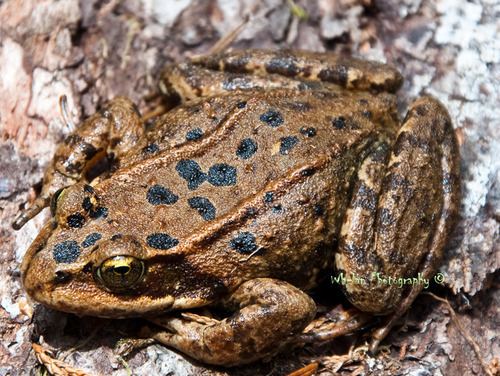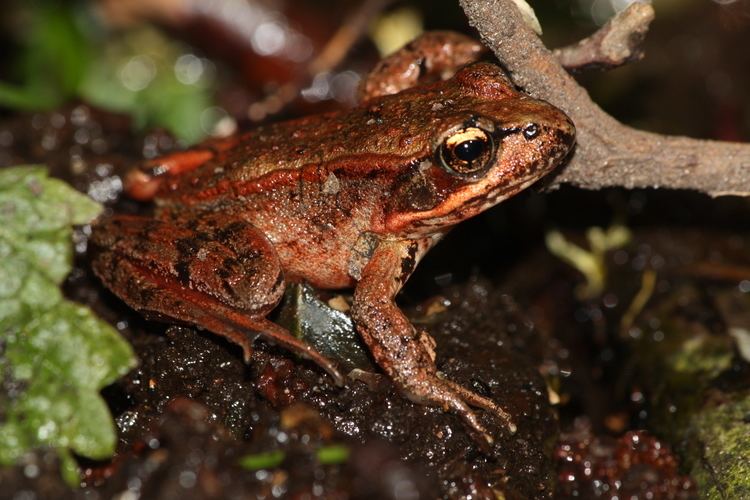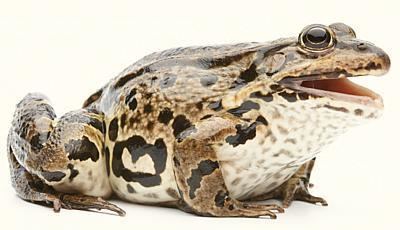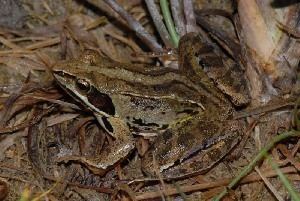Subphylum Vertebrata Suborder Neobatrachia Scientific name Rana Rank Genus | Phylum Chordata Order Anura Family Ranidae Higher classification True frog | |
 | ||
Lower classifications Common frog, Marsh frog, Moor frog, Agile frog, Pool frog | ||
Rana (commonly known as the Holarctic true frogs, pond frogs or brown frogs) is a genus of frogs. Members of this genus are found through much of Eurasia, North America, Central America, and the northern half of South America. Many other genera were formerly included here; see below for details.
Contents

These true frogs are usually largish species characterized by their slim waists and wrinkled skin; many have thin ridges running along their backs but they generally lack "warts" like in typical toads. They are excellent jumpers due to their long slender legs. The typical webbing found on their hind feet allows for easy movement through water. Coloration is mostly greens and browns above, with darker and yellowish spots.

Distribution and habitat

Many frogs in this genus breed in early spring, although subtropical and tropical species may breed throughout the year. Males of most of the species are known to call, but a few species are thought to be voiceless. Females lay eggs in rafts or large, globular clusters, and can produce up to 20,000 at one time.
Diet

Rana species feed mainly on insects and invertebrates, but will swallow anything they can fit into their mouths, including small vertebrates. Among their predators are egrets, crocodiles and snakes.
Systematics
Some 50 to 100 species are now placed in this genus by various authors; many other species formerly placed in Rana are now placed elsewhere. Frost (2006) restricted Rana to the Old World true frogs and the Eurasian brown and pond frogs of the common frog R. temporaria group., although other authors disagreed with this arrangement. In 2016, a consortium of Rana researchers from throughout Europe, Asia, and North America revised the group, and reported that the arrangement of Frost (2006) resulted in non-monophyletic groups. Yuan et al. (2016) included all the North American ranids within Rana, and used subgenera for the well differentiated species groups within Rana. Both of these classifications are presented below.
Genera recently split from Rana are Babina, Clinotarsus (including Nasirana), Glandirana, Hydrophylax, Hylarana, Lithobates, Odorrana (including Wurana), Pelophylax, Pulchrana, Sanguirana, and Sylvirana. Of these, Odorrana is so closely related to Rana proper, it could conceivably be included here once again. The others seem to be far more distant relatives, in particular Pelophylax.
New species are still being described in some numbers.
Species
Frost's (2006) classification includes the following species:
The revision of Rana by Yuan et al. (2016) includes the following species, arranged in subgenera: (This taxonomy has been adopted by AmphibiaWeb, available at http://amphibiaweb.org/, an online compendium of amphibian names and information.)
Notes on other taxonomic arrangements:
The harpist brown frog (also known as Kampira Falls frog or Yaeyama harpist frog) was formerly known as R. psaltes; it was subsequently identified as the long-known R. okinavana. The latter name has been misapplied to the Ryūkyū brown frog, but the harpist brown frog is a rather distinct species that apparently belongs in Babina or Nidirana if these are considered valid.
